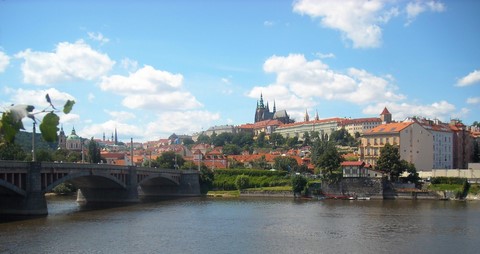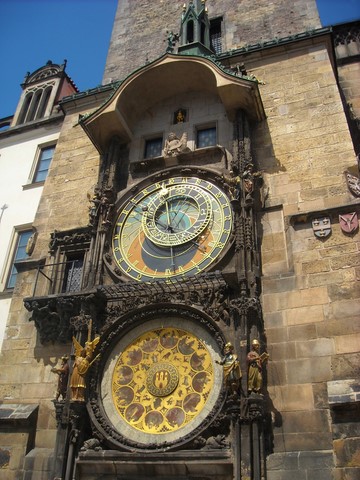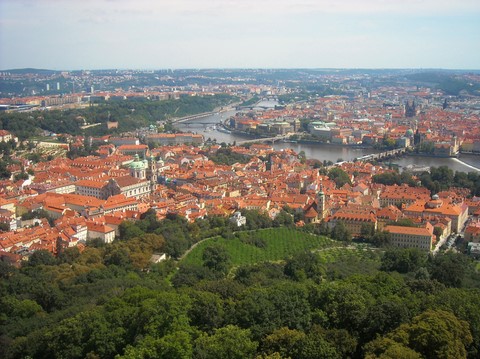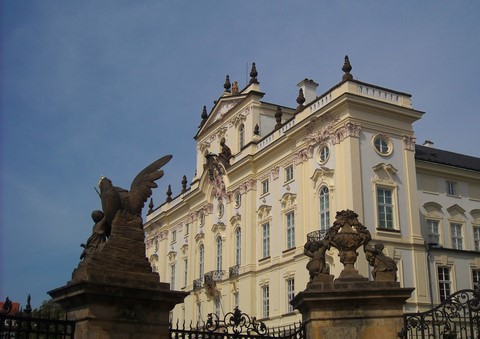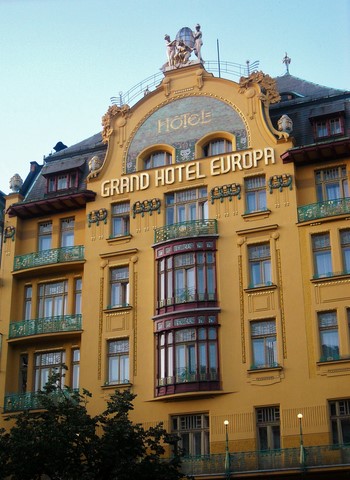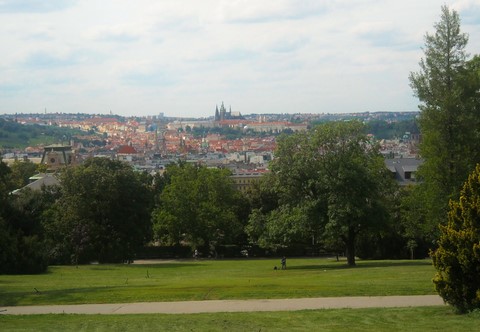Prague, «the city with one hundred steeples»
You can click on pictures to enlarge them
Paris, the most beautiful city in the world? We have often heard that phrase. Is it a reality or a certain chauvinism that pushes us to say so? We love Paris, and think it is a very pretty city. Moreover, we used to go back there with pleasure and delight each year. Yet, we think that it is not even the most beautiful city in Europe, which in our opinion returns to Prague, more colorful.
Between the Charles Bridge and the Petřín Hill, the Astronomical Clock and the Prague Castle overlooking the Vltava River, «the city with one hundred steeples» gets increasingly entrancing as you are discovering it.
Staré Město & Josefov Districts
It is hard not to get lost when you do not know Staré Město, the old town of Prague. Such as a maze, its streets are entangled, alleys turn round on themselves and its walkways obstruct the view. The district abounds with Baroque and Renaissance buildings. Romanesque façades are next to Art Nouveau façades. There are many churches and convents. The famous Charles Bridge, equipped with sumptuous statues, is the most visited place in town. It stretches across the Vltava River, highlighted with varied pastel colors buildings which makes the banks more attractive. As the city's main attraction, the Astronomical Clock (photo) really draws tens of people who come to admire that beautiful and amazing work of art six-hundred years old every hour of the day. The clock strikes, and the original mechanism activates the characters: the twelve apostles parade in the central window while the Reaper shakes the hourglass. The miser shakes his purse and the conceited tilts his mirror. The Turkish refuses with a head movement to follow the Reaper. The central dial indicates the position of the Sun, the Moon and the planets according to the medieval cosmology through three hands. A thunder of applause and acclaim welcomes the end of the short show.
Josefov is the Jewish District, old ghetto which witnesses the segregation against the Jews from 13th century to the 18th century. It has a very colored and polished up architecture. Most of its streets are more quiet than in Staré Město or Malá Strana… except tourist attractions, of course. However, you can walk away from them while stepping into small cobbled alleys steeped in authenticity. In the Jewish Graveyard, countless sloping tombstones tangled in a terrible mess, which gives it its attraction. It brings out its mysterious and magical side. Nearby stands the Jewish Museum and five synagogues. The most remarkable is the Spanish Synagogue.
See:
- Charles bridge
- Astronomical Clock
- Obecní Dům (Municipal House)
- Old Town Square
- The Old Town Bridge Tower
- Powder Tower
- Our Lady of Týn Church
- Rudolfinum
- Stone Bell House
- Jewish graveyard and synagogues
- Jewish Museum
Malá Strana District
In the other side of Charles Bridge stand the other major district in town. From the Castle perched on the Petřín Hill, the «small side» of Prague stretches its maze of paved alleys to the Charles Bridge. That lively area, with picturesque colorful facades, gathers around Nerudova, its main road which runs down the slope of Petřín to the Saint-Nicolas Church. You will notice a strong Latin influence according to architecture, for the most part Baroque and Renaissance styles. Besides, there once was an Italian area there. Narrow passages enter old houses courtyards. Sometimes open-air, they include cafes and terraces. Palaces abound. At nightfall, streets lit by lamps lead to surprising places with a beautiful fountain or a sculpture. Cafés and restaurants are lively.
The Petřín Tower rises up above the town, on a hill that has the same name. Miniature replica of the Eiffel Tower, it offers a splendid 360° view of the Czech capital (photo). Nearby, the rose garden and the wooded park are a treat to recover from the ascent of the Hill and the tower.
Kampa Island looks like a small village hung on the banks of the Vltava River under the Charles Bridge. Both close and far from the Prague tourist life, it will enchant you.
See:
- Saint-Nicolas Church
- Strahov Convent
- Petřín Labyrinth
- Petřín Tower
- Music Museum
- Kampa Island
Hradčany District
The Prague Castle (photo) dominates Hradčany throughout its impressive silhouette. The smallest district in town was destroyed by fire in 1541. Rebuilt in Renaissance style, the Habsburg Empire nobles took advantage of the opportunity to surround the castle with sumptuous palaces. Those ones added to the cathedral, churches and museums, courtyards and gardens, as well as a music pavilion make it an architectural grouping, which richness is matched only by its diversity. Nothing better also than strolling through Royal Gardens and enjoying the calm and the nature that surrounds the Castle.
The place is obviously popular with tourists. So, don’t hesitate to move away and join Lorette Square and its surroundings if you want peace and quiet and more authenticity.
See:
- Prague Castle
- Royal Gardens
- Our Lady of Lorette
- Garden on the ramparts
- Hradčany Square
- Saint-Georges Basilica
- Saint-Georges Convent
- Kafka Museum
Nové Město & Vyšehrad Districts
As you enter Nové Město district, you will be amazed by the radical change according to architecture. There, winding alleys are replaced by straight wide avenues punctuated with areas, particularly the beautiful Venceslas Square, which stretches out over 750 meters, where sumptuous colored buildings are dotted all along (photo). Styles are much diversified: modern style mixes with Baroque, Art Deco and Secession. The Art Nouveau decoration of the Central Station hall and dome is worth seeing on its own. You will be both stunned and amused by the curves of the Dancing House, modern tower made of glass and metal filled with originality, built by two architects: a Czech and an American. Business district at day, Nové Město is also much lively at night: bars, lounges, night clubs and cabarets are numerous there.
Not many people go to Vyšehrad district. Yet, it is filled with history. Perched on a hill, its Vyšehrad Castle is even older than that of Hradčany district. Its gates and its ramparts are worth visiting on their own. Do not forget to linger on the Saint-Martin Rotunda, the Saint-Peter-and-Paul Church and on the National Pantheon.
See:
- Venceslas Square
- Central Station
- Dancing House
- Franciscan Garden
- Communism Museum
- City of Prague Museum
- National Theater
- Villa Amerika & Dvorak Museum
- Vyšehrad Castle
- Saint-Martin Rotunda
- Saint-Peter-and-Paul Church
- National Pantheon.
Vinohrady & Žižkov Districts
Those two very authentic districts are where you will immerse yourselves best in the genuine Czech life, mingling with locals far from tourist attractions.
In the West of the city center, the Vinohrady district is distinguished by its large colorful Art Nouveau style houses. Located on a hill, Riegrovy Sady park (photo) offers a splendid view of the rooftops of Prague especially at sunset. Then, the Vltava River extends its golden shimmering rippers in the heart of magnificent buildings, in a gripping blaze of light. The atmosphere is young and festive. In the heart of the park stands a small restaurant (eat in or take out) where you can find many young locals. Feel free to take a local beer, enjoy a sausage in mustard sauce on a slice of whole-wheat bread, overlooking the Czech capital on the parks lawns on a slope. One evening, we saw with amusement teenagers on a sofa they had found in the street and carried to the park to admire sunset sitting comfortably.
Žižkov, the «red district», is distinguished by the countless ramshackle buildings erected during the Communist era. But it enjoys in compensation of the most hectic nightlife in town. Its main attraction is the 287 meters high Žižkov Tower, a TV Tower which includes restaurants and the amazing and costly One Room Hotel. The panoramic view of Prague is staggering.
See:
- Riegrovy Sady Park
- The Žižkov Hill
- The Žižkov Tower
- New Jewish Graveyard, which houses Franz Kafka’s tomb
- Army Museum
- National Memorial



